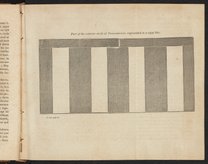Representation of pairs of stones at Stonehenge
- 1812
Engraved plate of pairs of stones at Stonehenge. The horizontal stone is called a "cap." On the adjacent page Silliman describes the condition of the pairs as he viewed them. One pair remains standing, one fell about seven or eight years ago, one pair has one set standing and the other on the ground, and one has one set broken while the other set is gone. More information on the pairs can be found on page 89.
This plate is from A Journal of Travels in England, Holland and Scotland, and of Two Passages Over the Atlantic, in the Years 1805 and 1806, Vol. 2., published in 1812. This travel log of Benjamin Silliman (1779-1864) details his research In England, Holland, and Scotland. Silliman founded the American Journal of Science and discovered a way to distill petroleum. Written in first-person, this book gives an insight into Silliman's personal feelings and observations about his experiences in several cities and towns across England, Holland, and Scotland, as well as his journey back to the United States. It notably contains several fold-out diagrams of Stonehenge.
| Property | Value |
|---|---|
| Author | |
| Printer | |
| Publisher | |
| Place of publication | |
| Format | |
| Genre | |
| Extent |
|
| Language | |
| Subject | |
| Rights | Public Domain Mark 1.0 |
| Credit line |
|
Institutional location
| Department |
|---|
Related Items
Cite as
Silliman, Benjamin. “Representation of Pairs of Stones at Stonehenge.” In A Journal of Travels in England, Holland and Scotland, and of Two Passages Over the Atlantic, in the Years 1805 and 1806, Vol. 2. New York, New York: Ezra Sargeant, 1812. https://digital.sciencehistory.org/works/1bi6ou5.
This citation is automatically generated and may contain errors.





